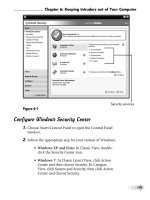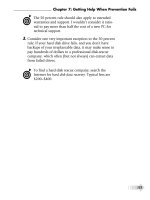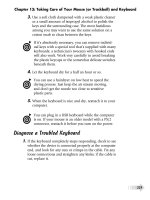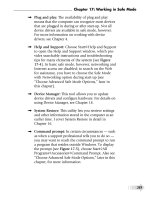Eric tyson investing in your 20s 30s for dummies for dummies (2012)
Bạn đang xem bản rút gọn của tài liệu. Xem và tải ngay bản đầy đủ của tài liệu tại đây (2.11 MB, 181 trang )
Investing in Your 20s & 30s For Dummies
®
Visit www.dummies.com/cheatsheet/investinginyour20s30s to view this book's
cheat sheet.
Table of Contents
Introduction
About This Book
Conventions Used in This Book
What You’re Not to Read
Foolish Assumptions
How This Book Is Organized
Part I: Understanding Investing Terms and Concepts
Part II: Preparing Your Investing Foundation
Part III: Beginning Investments
Part IV: Advanced Investments
Part V: The Part of Tens
Icons Used in This Book
Where to Go from Here
Part I: Understanding Investing Terms and Concepts
Chapter 1: Making Sense of Your Investing Options
Growing Your Money in Ownership Investments
Sharing in corporate growth and profits: Stocks
Profiting from real estate
Succeeding in small business
Keeping Money in Lending Investments
Understanding Risks and Returns
Understanding risks
Managing risks
Making sense of returns
Where to Invest and Get Advice
Finding the best fund companies and brokers
Finding an admirable advisor
Chapter 2: Using Investments to Accomplish Your Goals
Setting and Prioritizing Your Shorter-Term Goals
Accumulating a rainy-day fund
Saving for large purchases
Investing for a small business or home
Saving for kids’ educational costs
Investing short-term money
Investing in Retirement Accounts
Understanding retirement account perks
Grappling with retirement account concerns
Taking advantage of retirement accounts
Surveying retirement account choices
Selecting retirement account investments
Assessing Your Risk-Taking Desires
Chapter 3: Setting Your Return Expectations
Estimating Your Investment’s Returns
Money market funds and savings account returns
Bond returns
Stock returns
Real estate returns
Small-business returns
Compounding Your Returns
The value of getting a few extra percent
Considering your goals
Chapter 4: Minimizing Your Taxes When Investing
Understanding Investment Taxes
Tracking taxation of investment distributions
Determining your tax bracket
Devising tax-reduction strategies
Reducing Your Taxes When Selling Investments
Weighing nontax issues
Tuning in to tax considerations
Part II: Preparing Your Investing Foundation
Chapter 5: Laying Out Your Financial Plans
First Priorities: Paying Off High-Cost Debt and Building a Safety Reserve
Paying off high-cost consumer debt
Establishing an emergency reserve
What About Paying Down Other Debts?
Assessing student loans
Considering paying down mortgage debt
Sorting Out Your Financial Plans
Considering your investment options and desires
Assessing your savings rate
Investing regularly with dollar cost averaging
Knowing the Impact of Investing for College Costs
Paying for college
Considering educational savings account options
Investing money earmarked for college
Securing Proper Insurance
Chapter 6: Starting Out with Bank and Credit Union Accounts
Understanding FDIC Bank Insurance
Investing in Banking Account and Savings Vehicles
Bank checking accounts and debit cards
Savings accounts and certificates of deposit
Negotiating with Bankers
Feeling Secure with Your Bank
Evaluating any bank
Protecting yourself when banking online
Exploring Alternatives to Bank Accounts
Credit union accounts and benefits
Brokerage accounts
Money market mutual funds
Chapter 7: Managing Money Market Funds
Defining Money Market Mutual Funds
Making sense of the appeal of money market funds
Understanding the drawbacks of money market funds
Understanding Money Market Fund Holdings
Protecting and Accessing Your Money in Money Funds
Protecting your money
Accessing your money
Using Money Market Funds in Your Investment Plan
Shopping for the Best Money Funds
Understanding traits of leading money funds
Naming good money funds
Alternatives to Money Market Mutual Funds
Part III: Beginning Investments
Chapter 8: Getting Your Slice of Capitalism with Stocks
What Are Stocks?
How (And Why) You Can Make Money with Stocks
Understanding the importance of corporate profits
Making sense of how you profit with stocks
Timing Your Stock Buying and Selling
Following market indexes
Using price/earnings ratios to value stocks
Avoiding temptations and hype
Getting past the gloom
Sidestepping common investing minefields
Highlighting How to Invest in Stocks
Investing in stock mutual funds and exchange-traded funds
Picking your own stocks
Maximizing Your Stock Market Returns
Chapter 9: Securing Investment Income and Principal with Bonds
Defining Bonds
Understanding bond issuers
Considering credit (default) risk
Making sense of bond maturities
Using Bonds in a Portfolio
Finding uses for bonds
Comparing other lending investments with bonds
How and Where to Invest in Bonds
Choosing between bond funds and individual bonds
Investing in Treasury bonds
Investing in non-Treasury individual bonds
Evaluating individual bonds that you currently hold
Chapter 10: Investing in Funds: Mutual Funds and Exchange-Traded Funds
Understanding the Advantages of Funds
Maximizing Your Chances for Fund Investing Success
Understanding the importance of performance and risk
Examining fund management experience
Keeping costs down
Understanding and using index funds
Understanding exchange-traded funds: Index funds that trade
Creating and Managing a Fund Portfolio
Identifying the Best Mutual Funds and ETFs
Investing in the best ETFs
Picking the best stock funds
Balancing your act: Funds that combine stocks and bonds
Finding the best bond funds
Considering Alternatives to Investing in Funds
Your own online fund
Unit investment trusts
Brokerage managed accounts
Hedge funds for the wealthier
Part IV: Advanced Investments
Chapter 11: Seeking Shelter and Appreciation in Real Estate
Comparing Owning a Home to Renting
Weighing financial considerations
Considering costs and your time frame
Deciding when to buy
Figuring Your Home-Buying Budget
Getting your financial house in order
Determining your down payment
Doing lenders’ calculations
Shopping for Your Home
Understanding your housing options
Researching communities
Checking out and valuing a home
Investing in Investment Real Estate
Understanding real estate investment’s appeal
Sizing up real estate investment options
Conducting real estate investing research
Chapter 12: Taking Your Talents to the Small-Business Arena
Investing in Your Career
Deciding to Start Your Own Business
Weighing your options
Entrepreneuring at a company
Turning a Business Idea into Reality
Drawing up your business plan
Plotting to leave your job
Financing your business
Considering Small-Business Investment Options
Buying an existing business
Investing in someone else’s business
Chapter 13: Exploring Other Investment Vehicles
Considering Gold and Other Precious Metals
Contemplating Collectibles
Understanding the allure of collectibles
Seeing the realities of collectibles and their returns
Considering advice on buying collectibles
Understanding Annuities and Cash-Value Life Insurance
Availing yourself of annuities
Considering cash-value life insurance
Part V: The Part of Tens
Chapter 14: Ten Things to Know About Investing Resources
Get Educated to Discern the Best from the Rest
Beware “Free”
Understand the Influence of Advertising
Value Quality over Quantity
Know How to Check Out a Resource
Beware Hype and Exaggeration
Don’t Assume Quoted Experts Know Their Stuff
Investigate Gurus’ Claims
Don’t Believe Investment-Newsletter Claims
Check Out and Keep Up with My Favorite Resources
Chapter 15: Ten Essential Tips for Investing Success
Regularly Save and Invest 5 Percent to 10 Percent of Your Income
Understand and Use Your Employee Benefits
Thoroughly Research Before You Invest
Shun Investments with High Commissions and Expenses
Invest the Majority of Your Long-Term Money in Ownership Investments
Avoid Making Emotionally Based Financial Decisions
Make Investing Decisions Based on Your Plans and Needs
Tap Information Sources with High Quality Standards
Trust Yourself First
Invest in Yourself and Others
Cheat Sheet
Developing and Testing Your Investing Beliefs
What are your investing beliefs? Most investors haven’t taken the time to consider that question,
let alone to answer it. During the sharp stock market slide in 2008, some investors started
following particular gurus who claimed to have predicted the financial crisis. These investors
wanted to believe that someone out there could predict important financial events and tell folks
how to time their investments to benefit from what was about to unfold. Such market timing is a
fool’s errand. It sounds possible, and we’d like to believe that it is possible, but it’s not possible
on the scale various charlatans would have you believe.
As a reader of this book, you probably have a better idea of your investment beliefs than most
investors do. To help you along in this process, here are some beliefs for you to consider:
Your own personal comfort matters. A wide range of investments are available to you,
including stocks, exchange-traded funds (ETFs), mutual funds, real estate, and small
business. Some folks are simply more comfortable with particular investments, so you
shouldn’t force yourself into a portfolio that’s recommended as being best for you. Consider
the value of your time and your investing skills and desires. Investing in stocks and other
securities via the best mutual funds and ETFs is both time-efficient and profitable. Real
estate investing and running a small business are the most time-intensive investments.
Costs matter. The more you pay in commissions and management fees on your investments,
the greater the drag on your returns. And don’t fall prey to thinking that you get what you pay
for. Take advantage of tax-deductible retirement accounts, and understand the effect of your
tax bracket when investing outside tax-sheltered retirement accounts. Minimize your trading.
The more you trade, the more likely you are to make mistakes. Also, you suffer increased
transaction costs and higher taxes for non-retirement-account investments.
Market timing is much harder to predict than folks realize. Don’t bail when things look
bleak. The hardest time, psychologically, to hold on to your investments is when they’re
down. Even the best investments go through depressed periods, which is the worst possible
time to sell. Don’t sell when there’s a sale going on; if anything, consider buying more.
Ignore soothsayers and prognosticators. Predicting the future is nearly impossible.
There are better times than others to sell. When you’re really feeling good about an asset
class like stocks, and those assets have had a multiple-year run and are getting widespread
accolades, that’s a good time to lighten up if you have other good reasons for doing so. By
contrast, you can bump up your stock allocation if you’re comfortable doing so after a major
market decline.
Think long-term. Because ownership investments like stocks, real estate, and small
business are more volatile, you must keep your long-term perspective when investing in
them. Don’t invest money in such investments unless you plan to hold them for a minimum of
five years and preferably for a decade or longer.
Diversify. Diversification is a powerful investment concept that helps you reduce the risk of
holding more-aggressive investments. Diversifying simply means that you hold a variety of
investments that don’t move in tandem in different market environments. When investing in
stocks, for example, invest worldwide. You can diversify further by investing in real estate.
Emphasize value. Over the long term, value-oriented investments tend to produce higher
returns with less volatility than do pure growth-oriented investments.
Ignore the minutiae. Don’t feel mystified by or feel the need to follow the short-term
gyrations of the financial markets. Ultimately, the prices of stocks, bonds, and other financial
instruments are determined by supply and demand, which are influenced by thousands of
external issues, including millions of investors’ expectations and fears.
You are what you read and listen to. Don’t pollute your mind with bad investing strategies
and philosophies. The quality of what you read and listen to is far more important than the
quantity.
Praise for Eric Tyson
“Eric Tyson For President!!! Thanks for such a wonderful guide. With a clear, no-nonsense
approach to . . . investing for the long haul, Tyson’s book says it all without being the least bit
long-winded. Pick up a copy today. It’ll be your wisest investment ever!!!”
— Jim Beggs, VA
“Eric Tyson is doing something important — namely, helping people at all income levels to take
control of their financial futures. This book is a natural outgrowth of Tyson’s vision that he has
nurtured for years. Like Henry Ford, he wants to make something that was previously accessible
only to the wealthy accessible to middle-income Americans.”
— James C. Collins, coauthor of the national bestsellers Built to Last and Good to Great
“Among my favorite financial guides are . . . Eric Tyson’s Personal Finance For Dummies.”
— Jonathan Clements, The Wall Street Journal
“In Investing For Dummies, Tyson handily dispatches both the basics . . . and the more
complicated.”
— Lisa M. Sodders, The Capital-Journal
“Smart advice for dummies . . . skip the tomes . . . and buy Personal Finance For Dummies,
which rewards your candor with advice and comfort.”
— Temma Ehrenfeld, Newsweek
“Eric Tyson . . . seems the perfect writer for a …For Dummies book. He doesn’t tell you what to
do or consider doing without explaining the why’s and how’s — and the booby traps to avoid —
in plain English. . . . It will lead you through the thickets of your own finances as painlessly as I
can imagine.”
— Clarence Peterson, Chicago Tribune
“Personal Finance For Dummies is the perfect book for people who feel guilty about
inadequately managing their money but are intimidated by all of the publications out there. It’s a
painless way to learn how to take control.”
— Karen Tofte, producer, National Public Radio’s Sound Money
More Best-Selling For Dummies Titles by Eric Tyson
Personal Finance in Your 20s For Dummies®
This hands-on, friendly guide provides you with the targeted financial advice you need to establish
firm financial footing in your 20s and to secure your finances for years to come. When it comes to
protecting your financial future, starting sooner rather than later is the smartest thing you can do.
Also check out Personal Finance For Dummies.
Mutual Funds For Dummies®
This best-selling guide is now updated to include current fund and portfolio recommendations.
Using the practical tips and techniques, you’ll design a mutual fund investment plan suited for your
income, lifestyle, and risk preferences.
Home Buying For Dummies®
America’s No. 1 real estate book includes coverage of online resources in addition to sound
financial advice from Eric Tyson and front-line real estate insights from industry veteran Ray
Brown. Also available from America’s best-selling real estate team of Tyson and Brown —
House Selling For Dummies and Mortgages For Dummies.
Real Estate Investing For Dummies®
Real estate is a proven wealth-building investment, but many people don’t know how to go about
making and managing rental property investments. Real estate and property management expert
Robert Griswold and Eric Tyson cover the gamut of property investment options, strategies, and
techniques.
Small Business For Dummies®
Take control of your future, and make the leap from employee to entrepreneur with this
enterprising guide. From drafting a business plan to managing costs, you’ll profit from expert
advice and real-world examples that cover every aspect of building your own business.
Investing in Your 20s & 30s For Dummies
by Eric Tyson, MBA
®
Investing in Your 20s & 30s For Dummies®
Published by
John Wiley & Sons, Inc.
111 River St.
Hoboken, NJ 07030-5774
Copyright © 2013 by Eric Tyson
Published by John Wiley & Sons, Inc., Hoboken, New Jersey
Published simultaneously in Canada
No part of this publication may be reproduced, stored in a retrieval system or transmitted in any
form or by any means, electronic, mechanical, photocopying, recording, scanning or otherwise,
except as permitted under Sections 107 or 108 of the 1976 United States Copyright Act, without
the prior written permission of the Publisher. Requests to the Publisher for permission should be
addressed to the Permissions Department, John Wiley & Sons, Inc., 111 River Street, Hoboken,
NJ 07030, (201) 748-6011, fax (201) 748-6008, or online at
/>Trademarks: Wiley, the Wiley logo, For Dummies, the Dummies Man logo, A Reference for the
Rest of Us!, The Dummies Way, Dummies Daily, The Fun and Easy Way, Dummies.com, Making
Everything Easier, and related trade dress are trademarks or registered trademarks of John Wiley
& Sons, Inc., and/or its affiliates in the United States and other countries, and may not be used
without written permission. All other trademarks are the property of their respective owners. John
Wiley & Sons, Inc., is not associated with any product or vendor mentioned in this book.
Limit of Liability/Disclaimer of Warranty: The publisher and the author make no representations
or warranties with respect to the accuracy or completeness of the contents of this work and
specifically disclaim all warranties, including without limitation warranties of fitness for a
particular purpose. No warranty may be created or extended by sales or promotional materials.
The advice and strategies contained herein may not be suitable for every situation. This work is
sold with the understanding that the publisher is not engaged in rendering legal, accounting, or
other professional services. If professional assistance is required, the services of a competent
professional person should be sought. Neither the publisher nor the author shall be liable for
damages arising herefrom. The fact that an organization or Website is referred to in this work as a
citation and/or a potential source of further information does not mean that the author or the
publisher endorses the information the organization or Website may provide or recommendations
it may make. Further, readers should be aware that Internet Websites listed in this work may have
changed or disappeared between when this work was written and when it is read.
For general information on our other products and services, please contact our Customer Care
Department within the U.S. at 877-762-2974, outside the U.S. at 317-572-3993, or fax 317-5724002.
For technical support, please visit www.wiley.com/techsupport.
Wiley publishes in a variety of print and electronic formats and by print-on-demand. Some
material included with standard print versions of this book may not be included in e-books or in
print-on-demand. If this book refers to media such as a CD or DVD that is not included in the
version you purchased, you may download this material at . For
more information about Wiley products, visit www.wiley.com.
Library of Congress Control Number: 2012951870
ISBN 978-1-118-41123-0 (pbk); ISBN 978-1-118-46092-4 (ebk); ISBN 978-1-118-46090-0
(ebk); ISBN 978-1-118-46091-7 (ebk)
Manufactured in the United States of America
10 9 8 7 6 5 4 3 2 1
About the Author
Eric Tyson is an internationally acclaimed and best-selling personal finance author, lecturer,
speaker, and former advisor. Through his work, he is dedicated to teaching people to manage their
money better and to successfully direct their own investments.
Eric is a former management consultant to businesses for which he helped improve operations and
profitability. Before, during, and after this time of working crazy hours and traveling too much, he
had the good sense to focus on financial matters.
He has been involved in the investing markets in many capacities for more than three decades.
Eric first invested in mutual funds back in the mid-1970s, when he opened a mutual fund account at
Fidelity. With the assistance of Dr. Martin Zweig, a now-famous investment market analyst, Eric
won his high school’s science fair in 1976 for a project on what influences the stock market. In
addition to investing in securities over the decades, Eric has successfully invested in real estate
and started and managed his own business. He has counseled thousands of clients on a variety of
investment quandaries and questions.
He earned a bachelor’s degree in economics at Yale and an MBA at the Stanford Graduate School
of Business. Despite these impediments to lucid reasoning, he came to his senses and decided that
life was too short to spend it working long hours and waiting in airports for the benefit of larger
companies.
An accomplished freelance personal finance writer, Eric is the author of numerous best-selling
books, including For Dummies books on personal finance, investing, mutual funds, and home
buying (co-author), and is a syndicated columnist. His work has been featured and quoted in
hundreds of national and local publications, including Kiplinger’s Personal Finance Magazine,
Los Angeles Times, Chicago Tribune, The Wall Street Journal, and Bottom Line/Personal, and
on NBC’s Today Show, ABC, CNBC, PBS’s Nightly Business Report, FOX, CNN, CBS national
radio, Bloomberg Business Radio, National Public Radio, and Business Radio Network. He’s
also been a featured speaker at a White House conference on retirement planning.
You can visit him on the web at www.erictyson.com.
Dedication
Actually, before I get to the thank yous, please allow me a really major thank you and dedication.
This book is hereby and irrevocably dedicated to my family and friends, as well as to my former
students, counseling clients, and customers, who ultimately taught me everything I know about how
to explain financial terms and strategies so that all of us may benefit.
Author’s Acknowledgments
First, I’d like to thank Elizabeth Rea. Thanks also to Kathy Simpson for all of her fine editing and
to all of the fine folks in Composition and Graphics for making this book look great! Thanks also
to everyone else who contributed to getting this book done well and on time.
And last but not least, a tip of my cap to the fine technical reviewers — Gary Karz and John
Nelson — who helped to ensure that I didn’t write something that wasn’t quite right. . . .
Publisher’s Acknowledgments
We’re proud of this book; please send us your comments at . For other
comments, please contact our Customer Care Department within the U.S. at 877-762-2974, outside
the U.S. at 317-572-3993, or fax 317-572-4002.
Some of the people who helped bring this book to market include the following:
Acquisitions, Editorial, and Vertical Websites
Project Editor: Elizabeth Rea
Acquisitions Editor: Erin Calligan Mooney
Copy Editor: Kathy Simpson
Assistant Editor: David Lutton
Editorial Program Coordinator: Joe Niesen
Technical Editors: Gary Karz, CFA; John L. Nelson, CFA
Editorial Manager: Michelle Hacker
Editorial Assistant: Alexa Koschier
Cover Photos: © iStockphoto.com/vova Kalina, © iStockphoto.com/pictafolio
Cartoons: Rich Tennant (www.the5thwave.com)
Composition Services
Project Coordinator: Kristie Rees
Layout and Graphics: Jennifer Creasey, Joyce Haughey, Laura Westhuis
Proofreaders: Cynthia Fields, Lauren Mandelbaum
Indexer: Dakota Indexing
Publishing and Editorial for Consumer Dummies
Kathleen Nebenhaus, Vice President and Executive Publisher
David Palmer, Associate Publisher
Kristin Ferguson-Wagstaffe, Product Development Director
Publishing for Technology Dummies
Andy Cummings, Vice President and Publisher
Composition Services
Debbie Stailey, Director of Composition Services
Introduction
Investing offers so many possibilities and so many choices.
Your young adult years, which at least for the purposes of this book I define as your 20s and 30s,
are filled with so much promise and potential. Your career, your interests, your personal life, and
your family and friends all compete for your time and attention.
Most folks work upward of 2,000 hours per year earning a living. Managing the money that passes
through their hands is an important task, which most folks aren’t trained to do.
Earning money generally takes a lot of work. Managing your personal finances and saving money
take discipline and sacrifice. When you have money to invest, you want to do the best that you can
so that you earn a decent return without ending up in failed investments.
About This Book
I designed and wrote this book to help you with the important and challenging task of investing.
Your young adult years are a great time to lay the best foundation for investing wisely. After all,
some of the investments you make now and in the near future will have decades to grow and
multiply.
I’ve worked with and taught people from all financial situations, so I know the investing concerns
and questions of real folks just like you. I’ve discovered how important having healthy and strong
personal finances and investments is.
I first became interested in money matters as a middle-school student when my father was laid off
and received some retirement money. I worked with my dad to make investing decisions with the
money. A couple of years later, I won my high school’s science fair with a project on what
influences the stock market.
During my younger adult years, I worked hard to keep my living expenses low and to save and
invest money so that I could leave my job and pursue my entrepreneurial ideas. I accomplished
that goal in my late 20s. I hope to give you some tools to help you make the most of your money
and investments so you too can meet your goals and dreams.
Conventions Used in This Book
To help you navigate the waters of this book, I’ve set up a few conventions:
I use italics for emphasis and to highlight new words or terms that I define.
I use boldface text to indicate the action part of numbered steps and to highlight key words
or phrases in bulleted lists.
I put all web addresses in monofont for easy identification.
What You’re Not to Read
I’ve written this book so you can find information easily and easily understand what you find. And
although I’d like to believe that you want to pore over every last word between the two yellowand-black covers, I actually make it easy for you to identify “skippable” material. The sidebars
are the shaded boxes that appear here and there. They include helpful information and
observations that, while interesting, aren’t essential for you to know.
Foolish Assumptions
No matter what your current situation is — whether you’re entering the job market right after high
school, graduating college with a large amount of student loans, pretty well established in your
career, and so on — I thought of you as I wrote this book and made some assumptions about you:
You want expert advice about important investing topics such as getting a preinvesting
financial checkup, understanding the range of investments available, and assembling a killer
investment portfolio. And you want that advice quickly.
You want a crash course in investing and are looking for a book you can read cover to cover
to help solidify major concepts and get you thinking about your investments in a more
comprehensive way.
You’re tired of feeling overwhelmed by your investing choices and stressed out by the everchanging economic and investing landscape, and you want to get more comfortable with your
investment selections.
This book is basic enough to help a novice get his or her arms around thorny investing issues. But
advanced readers will be challenged as well to think about their investments and finances in a new
way and identify areas for improvement. Check out the table of contents for a chapter-by-chapter
rundown of what this book offers. You can also look up a specific topic in the index. Or you can
turn a few pages and start at the beginning: Chapter 1.
How This Book Is Organized
Investing in Your 20s and 30s For Dummies is organized into five parts, with each covering a
major area of investing. The chapters within each part focus on specific elements or avenues of
investing in detail. Here are the highlights of what you can find in each part.
Part I: Understanding Investing Terms and Concepts
In this part, I help you make sense of all the investing lingo that’s out there, including
understanding folks who claim to be able to help you make investing decisions. I also explain how
to set and achieve common goals with your investments. This part closes by discussing the
reasonable returns to expect from various investments, how those returns compound over time,
how taxes work on investments, and what you can do to minimize your investment taxes.
Part II: Preparing Your Investing Foundation
In this part, I explain how your financial plans should translate into your investing plans and what
financial housekeeping you should do before investing. I also explain what role bank and credit
union accounts can play in your investment portfolio and what alternatives can make you more
money. Finally, I discuss money market mutual funds and how to select the right one for your
situation.
Part III: Beginning Investments
You don’t already have to be rich to tap into the best investments! In this part, I explain how stocks
and bonds work and how to make money in them. I also cover fund investing — specifically,
investing in mutual funds and exchange-traded funds. I discuss how to match funds to your
objectives, how to create and manage a fund portfolio, and how to choose among alternatives to
funds.
Part IV: Advanced Investments
This part covers more advanced and complicated investments that you should consider. I start with
real estate, which not only could include a home in which you live, but also investment property
you would rent out. Then I move on to small-business investing, which can include starting your
own company, buying a company, and possibly investing in someone else’s company. I close by
discussing some other investments, including annuities, insurance, collectibles, gold, and other
commodities.
Part V: The Part of Tens
In this part, I present some lists of ten-somethings that can help you with your finances. The topics
covered are the ten things you need to know about information resources and the ten principles of
investing success.
Icons Used in This Book
The icons in this book help you find particular kinds of information that may be of use to you:
This target marks strategy recommendations for making the most of your investments.
This icon points out information that you’ll definitely want to remember.
This icon marks things to avoid and points out common mistakes people make when
making and managing their investments.
This icon alerts you to scams and scoundrels who prey on the unsuspecting.
This icon tells you when you should consider doing some additional research. Don’t
worry — I explain what to look for and what to look out for.
Where to Go from Here
This book is organized so you can go wherever you want to find complete information. You can
use the table of contents to find broad categories of information or the index to look up more
specific topics.
If you’re not sure where you want to go, you may want to start with Part I. It gives you all the basic
info you need to assess your financial and investing situation and points to places where you can
find more detailed information for improving it.
Part I
Understanding Investing Terms and
Concepts
In this part...
I cover conceptual material starting with defining commonly used investing jargon, including
explaining the different types of investments, along with their expected returns and risks. I also
delve into how to use investments to accomplish your goals, such as making larger purchases,
buying a home, and investing for retirement. Lastly, I discuss how investment returns are taxed and
what you can legally do to minimize your taxes on your investments.
Chapter 1
Making Sense of Your Investing Options
In This Chapter
Common investments and how they compare
Investment terminology explained — risks and returns
The gobbledygook of professionals, credentials, and investment companies
So many fields and disciplines are packed full of jargon. Some of this is the result of “progress”
and advances, and some of it is caused by workers in the field not going out of their way enough to
explain and define things.
In this chapter, I give you the lay of the land regarding the enormous numbers of choices and
foreign-sounding terminology that await you in the world of investing. I also explain the types of
companies that offer investments and their strengths and weaknesses. And should you want to hire
some investing help, I also detail the various professionals pitching their services to you and the
common credentials they hawk to convince you of their expertise.
Growing Your Money in Ownership Investments
The most exciting thing about investing during your younger adult years is that you can be more
aggressive with money that you’ve earmarked to help you accomplish long-term goals. To achieve
typical longer-term financial goals, such as retiring, the money that you save and invest generally
needs to grow at a rate much faster than the rate of inflation. If you put your money in a bank
account that pays little or no interest, for example, you’re likely to fall short of your goals.
Ownership investments are investments like stocks, where you own a piece of a company, real
estate, or a small business that has the capability to generate revenue and profits. Over the long
term, consider ownership investments if you want your money to grow much faster than the rate of
inflation and don’t mind more volatility in your investments’ values.
The downside to such investments is that they can fall more significantly in value than nonownership investments, especially in the short term. So don’t put money into ownership
investments that you may need to tap in the short term for rent money or your next vacation. To
reduce the risk of ownership investments, diversify — that is, hold different types of ownership
investments that don’t move in tandem.
I cover three major ownership investments in the following sections: stocks, real estate, and small
business.
Sharing in corporate growth and profits: Stocks
If you want the potential to share in the growth and profits of companies, you can gain it through
buying shares of their stock. Stocks are shares of ownership in a company. You can buy stock
directly in individual companies through a brokerage account, or you can buy a collection of
stocks via a mutual fund or exchange-traded fund (see Chapter 10).
You don’t need to be a business genius to make money in stocks. Simply make regular and
systematic investments, and invest in proven companies and funds while minimizing your
investment expenses and taxes. Of course, there’s no guarantee that every stock or stock fund
that you buy will increase in value. In Chapter 8, I explain proven and time-tested methods
for making money in stocks.
Profiting from real estate
You don’t need to be a high roller to make money investing in real estate. Owning and managing
real estate is like running a small business: You need to satisfy customers (tenants), manage your
costs, keep an eye on the competition, and so on. Some methods of real estate investing require
more time than others, but many are proven ways to build wealth.
Among the key attributes of real estate investment are the following:
You build wealth through your rental income exceeding your expenses and through propertyvalue appreciation.
You can leverage your investment by borrowing money.
You must be comfortable dealing with property management, which includes finding and
retaining tenants and keeping up (and possibly improving) your property.
See Chapter 11 for the details on investing in real estate.
Succeeding in small business
I know people who have hit investing home runs by owning or buying businesses. Most people
work full-time at running their businesses, increasing their chances of doing something big
financially with them. Investing in the stock market, by contrast, tends to be more part-time in
nature.
In addition to the financial rewards, however, small-business owners can enjoy seeing the impact
of their work and knowing that it makes a difference. I can speak from firsthand experience (as can
other small-business owners) in saying that emotionally and financially, entrepreneurship is a
roller coaster.
Besides starting your own company, you can share in the economic rewards of the entrepreneurial









